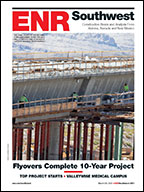The Colorado Dept. of Transportation celebrated the June 22 completion of Phase 1 of the U.S. 36 Express Lanes Project. CDOT was joined in the grand opening ceremony by its partners, the Regional Transportation District, the High Performance Transportation Enterprise, the U.S. Dept. of Transportation and the Federal Highway Administration. Along with elected officials and many stakeholders, the agencies marked the end of major construction impacts and the beginning of multi-modal choices on the newly reconstructed highway that connects Denver to Boulder.

“This project represents the future of transportation in Colorado,” said Gov. John Hickenlooper. “We know from experience that we can’t build our way out of congestion. You have to build smarter, by offering choice in the way people travel. U.S. 36 is a model of how a multi-modal highway in a public-private partnership will help this state’s critical corridor meet its growing demands.”
The U.S. 36 Express Lanes Project began in summer 2012 with construction phasing that allowed the highway to remain open during peak travel times while Ames Granite Joint Venture, the construction contractor, rebuilt the general purpose lanes, reconstructed five major bridges and widened three more, and added a bikeway along the length of the project. Phase 1 of the project is 11 miles long, from Federal Boulevard to 88th Street in Louisville/Superior.
Known locally as the “innovation corridor,” U.S. 36 was built with the well-defined strategy of moving traffic more efficiently rather than merely building additional lanes. The new Express Lanes can be used for RTD’s new Flatiron Flyer Bus Rapid Transit (BRT) system, for carpooling or for people who choose to pay a toll.
“We are proud to open the first truly multi-modal system in the state,” said CDOT Executive Director Shailen Bhatt. “U.S. 36’s innovation in design and financing is necessary to address the state’s infrastructure needs and the corridor had tremendous foresight when planning began more than 10 years ago.”
U.S. Dept. of Transportation Deputy Secretary Victor Mendez added, “U.S. 36 is a national model, not only for the innovative way it was built but also for the way in which the communities came together to leverage local, federal and private money and ensure the financing was in place to make it happen.”
In addition to the state’s first buffer-separated express lanes and the first BRT system, the project also includes the first:
• The first bus-on-shoulder system. Local buses are allowed to use the shoulder when traffic speeds fall below 35 mph, helping to get riders where they need to go more efficiently.
• The first active traffic management system. A system that uses input from devices installed on the roadway (cameras and vehicle detectors) to collect information about current traffic conditions and communicate to drivers about accidents ahead or reduced travel speed.
• The first commuter-specific bike lanes along a Colorado highway.
“Colorado has long been ahead of the curve when it comes to transportation,” said U.S. Rep. Ed Perlmutter. “We are a state of innovative thinkers who put that thinking into action. I couldn’t be more proud to celebrate the completion of yet another model project for the state.”
Phase 1 of U.S. 36 is open to drivers, but toll collection is currently being waived while the lanes undergo a brief testing period until mid-July to ensure that the tolling equipment and technology is working properly for all vehicles. Drivers are encouraged to get a pass before tolling begins.
Phase 2 of U.S. 36, from 88th Street in Louisville/Superior to Table Mesa in Boulder, is still under construction and will be open in early 2016. Phase 2 also includes rebuilding general purpose lanes, adding an express lane in each direction and making improvements to three bridges, including at McCaslin, which will accommodate the area’s first diverging diamond interchange.
Phase 2 is being built in partnership with RTD, HPTE and Plenary Roads Denver as CDOT’s first public-private partnership. Plenary—a consortium of Plenary Group, Ames Construction, Granite Construction, HDR and Transfield Services—is designing, building and financing Phase 2, and will operate and maintain Phases 1 and 2 and the I-25 Express Lanes into Denver.


Post a comment to this article
Report Abusive Comment